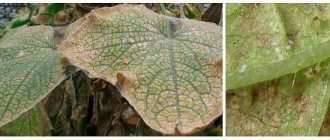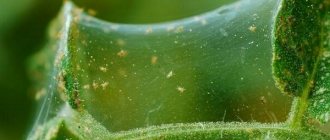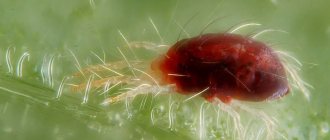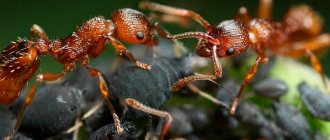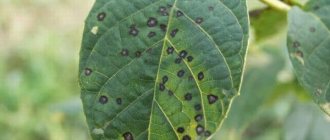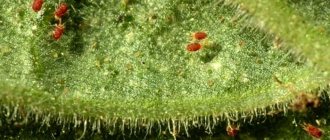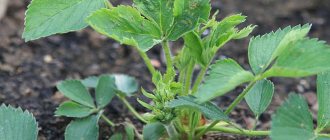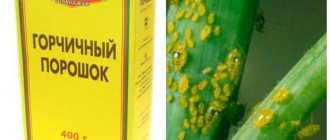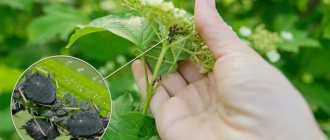In the rose flower garden, one of the most malicious garden pests, the spider mite, poses a serious danger. It hides on the underside of leaves and sucks cell sap from plants. If the dirty bug has just been discovered, then you can get rid of it by resorting to folk remedies, many of which show their high effectiveness in the fight against many harmful insects.
A few words about the pest
The spider mite is a small oval-shaped arachnid insect, 1 millimeter in size, red in color (the larvae are light green).
Plant sap is the main food of the pest. The insect is an omnivore; it attacks absolutely all plants it comes across on its way. Can be transported over long distances using its web. At air temperatures above +23 degrees, the mite multiplies quickly, laying up to several hundred eggs on the leaves. The larvae are particularly gluttonous - they drink plant juice. In this case, the process of photosynthesis is disrupted, the plant is depleted and dies. Attention!
Spider mites most often attack young bushes that do not have strong immunity. When exposed to the pest, such bushes do not have time to form buds.
Who is this?
Spider mites (lat. Tetranychidae) are an animal that belongs to the phylum arthropods, class arachnids, subclass mites. The most famous member of the family is the common spider mite. It is a pest of indoor, garden and agricultural crops. It is found on all continents where there is vegetation, except Antarctica.
How is it different from other types?
The main distinguishing feature of the spider mite is the ability to secrete cobwebs , which is why it got its name. They wrap the plant with this thin veil, in which they then live. This species can also change from green to orange or red. It all depends on what the parasite eats and where it lives.
What are the reasons for the appearance?
Maintaining a collection of indoor flowers at the proper level requires constant replenishment. Infection can occur:
- when purchasing a new copy;
- because of a bouquet of flowers brought;
- during the exchange of sprouts between gardeners;
- when a tick enters a room with the wind through an open window or vent.
There is nothing to be done here, because it is visually difficult to recognize the presence of spider mites on the plant . At first, it may be inactive, being in a state of diapause.
Most often, the pest settles on plants with tender and succulent foliage, in particular indoor roses. And, as a rule, roses are grown in warm and dry conditions, mistakenly believing that this microclimate is as comfortable as possible for the flower. Meanwhile, such parameters are the most successful for the active reproduction of spider mites. And if measures are not taken in time, then in a fairly short time all nearby flowers will be infected.
A harmful insect can also damage a flower if it is not properly cared for. For example, during the active growing season, a rose requires a sufficient amount of water; if there is not enough water, there is a high risk of being attacked by mites.
Description of the pest
Tetranychidae are omnivorous pests that differ in internal structure from insects. The length of females is on average 0.5 mm, and males are even smaller. Mites have 4 pairs of legs, while sucking insects have 3 pairs. The body is elongated, flat, divided into three sections. It does not have a chitinous cover. The structure of the eyes is simple, there are two pairs of them. The spider mite's mouthparts are sucking.
Ticks live in colonies. One generation of spider mite lives from 12 to 24 days . The female lays over 100 eggs during her life. So in a year animals can leave from 8 to 18 generations. The higher the temperature and the drier the air, the more actively pests develop. Under unfavorable conditions, ticks fall into suspended animation, and in this state they can remain in dry leaves and soil for a long time, without losing their viability.
Read more about diseases and pests of roses in another publication.
What is the danger?
Spider mites cause irreparable damage to the plant, even death. It is placed on the back side of the leaves of a houseplant and the juice is sucked out. Depending on the number of Tetranychidae individuals, one can judge the condition of the indoor rose, but in any case it does not look healthy and blooming.
First, the pest damages the lower parts of the flower, then moves to the outer side of the leaf plate. Then it damages the young shoots. When infested en masse, pests destroy inflorescences and all non-woody parts of the rose.
How is the plant affected?
On an indoor rose, the presence of a spider mite can be recognized by the following external signs :
- sickly appearance of the flower;
- the appearance of white dots on the leaf, which increase in size over time, taking on the appearance of spots;
- the presence of a thin web on the inflorescences and leaves of the rose;
- curling of green leaves, followed by drying out and dying;
- the foliage turns pale, turns yellow, the inflorescences become smaller in size (this and other reasons for the yellowing of rose leaves are discussed in more detail in another article).
Causes of infection
If the tick has already reached your garden, then in a couple of weeks its numerous offspring will “rule” all the flora growing in the area. It does not bypass vegetables, fruit trees or flowers. The pest spreads by air, that is, it is carried by the wind from plant to plant. Pets can also “help” the parasite (bring it on their fur). Typically, territory acquisition occurs during hot, dry weather when dusty conditions occur. First, the mite falls on plants growing on the outskirts of the site, and then, with each new wind flow, it moves inside the garden.
Most often, those roses that are affected by mites are those that have not received proper human care. Without regular fertilizing, tillage, pruning, plant immunity is weakened - such flowers cannot resist the onslaught of the enemy. The situation is aggravated if the plantings are very thick and shoots grow in them.
Fact! Illiterate care of roses is the cause of spider mites. With insufficient watering and dense planting, roses have little chance of survival.
Signs of plant damage
The spider mite has a peculiar proboscis, with which it attaches itself to the leaves of plants and sucks out their juice. It is the juice that is the main food of parasites. Moreover, any plant, not just roses, can serve as a food source.
Affected leaves
The saliva of mites contains a special enzyme, which, when it gets on the leaves, promotes the destruction of chlorophyll and impedes photosynthesis. The leaves become covered with white spots, turn yellow and fall off. Infected bushes, deprived of sap, weaken, shoots develop poorly, inflorescences lag behind in development, become weak, and in general the entire bush looks small, undeveloped and sick. The weakening of the culture contributes to infection with various infections and diseases.
As a rule, the beginning of the spread of the mite goes unnoticed; not all gardeners pay attention to single changes in the leaves. When the colony grows greatly, the appearance of arthropods becomes noticeable - the bushes and buds seem to be entangled in a web, and numerous colonies themselves can already be seen on the stems.
Mite on a rose
If the problem has reached such proportions, it is necessary to immediately take measures to destroy the mites in order to prevent their further spread not only to roses, but also to other plants, which can lead to loss of harvest.
Inadequate care of flowers and other plants is a factor contributing to the proliferation of mites. Abundant and timely watering will create unsuitable conditions for the pest.
Signs and how to recognize mites on roses
This insect is so small that it can be very difficult to recognize it on the lacy leaves of rose bushes. This can only be done with a magnifying glass. You can detect a mite with the naked eye when it grows in size, but most often at this stage it is no longer possible to save the flowers. The mite prefers to live and reproduce on the underside of the leaf. The tick family grows very quickly - the number of colonies can reach several hundred voracious individuals.
The areas of parasitic influence of the mite are covered with white spots - it is their presence that should alert and suggest that the rose has been damaged by a mite. Over time, these spots grow, and the axils of the leaves become entangled in a thin whitish web. The affected leaves turn yellow, dry out and then fall off. If no measures are taken, the web can completely envelop the bush, including the buds, which become mummified and then fall off. When increased many times over, the population appears as a large teeming mass of red color. In this case, the plant may completely lose its leaves and flowers, and the stem will be covered with a strong thread of cobwebs. Such a bush will have to be dug up and destroyed.
By the way! Indoor roses are especially susceptible to mite attacks.
Signs of spider mite infestation
In the initial stages, few people notice the appearance of the pest. Treatment usually begins when tiny parasites have already settled on flowers, having managed to disrupt their integrity at the cellular level. Without enough nutrients and oxygen, the plant noticeably weakens, and that’s when its owners discover the problem.
How to recognize your enemy by sight
It is possible to examine the enemy destroying flowers grown with such difficulty only with the help of magnifying devices: a magnifying glass or a microscope. The size of the parasite is small, females reach a length of 0.6 mm, males are even smaller - up to 0.45 mm (see photo).
The common spider mite, which most often appears on both indoor and garden roses, has an oval soft body covered with hairs and colored in different shades of red - from coral to purple. Belongs to arachnids, adults have 8 legs. The larvae are transparent with a greenish or mustard tint.
Ticks are not insects and it is useless to fight them with insecticides. It is necessary to choose potent acaricidal or insectoacaricidal agents.
The best condition for the reproduction of dangerous arthropods is warm, dry air, which is exactly what happens in the hot summer or during the heating season. The pest forms large clusters and is capable of increasing its numbers tens of times in 15–20 days. Females lay hundreds of eggs, from which larvae emerge within a month, requiring increased nutrition. They especially “love” young and tender pink shoots. But the mite is a polyphage and, once it appears in a house, it can destroy many indoor plants.
By turning over the affected leaves, it is easy to detect rapidly moving red dots. This is what a spider looks like when you look at it with the naked eye. Experienced gardeners periodically bring a sheet of white paper to the rose bushes and shake the branches. Ticks, if present, will definitely fall and be noticed.
Where can the danger come from?
Pests do not fly, but they are often blown into open windows by the wind from nearby trees. Adults, eggs or larvae enter the home on shoes, clothing and animal fur. But the main carriers of this miniature predator remain infected ornamental plants.
Even buying indoor flowers from a trusted store does not guarantee their quality. The disease does not appear immediately, but by the time the danger becomes visible, the parasites will have time to spread.
Therefore, there is no need to rush to put your purchase on the windowsill of the “old-timers”; it is better to organize a quarantine for it. Ideally, “settle” in a separate room for 1 month. If this is not possible, place it away from others, maintaining a 3-meter distance.
During the period of isolation, the plant must be inspected several times, paying attention to the underside of the leaves and the stems of young shoots. Ticks live there. To prevent the “newbie”, they are treated with “Fitoverm” and other broad-spectrum biological preparations that are harmless to people and pets.
Main signs of the disease
Numerous light spots on young greenery are the first signal about the appearance of a tick. When cobwebs are visible on the roses and the leaves dry out, the infection has reached a critical stage and it is much more difficult to fight it. Small discolored spots form where the pest makes punctures to feed on the plant's sap. As the parasite colony grows, the leaf surface damaged by them increases. The spots merge into single fields, and the first threads of the web appear in the places where the cuttings are attached to the main stem.
Having lost the ability to synthesize nutrients, the leaves turn yellow or gray, curl and fall off. When exposed to light, they are openwork, without some of the pulp. Sometimes leaf plates become deformed - this is also one of the signs of pests.
A severely affected bush looks like this:
- Some of the leaves are covered with a coating, as if dusty.
- Not only individual shoots, but also entire branches with buds are entwined with several layers of cobwebs, on which clusters of parasites are noticeable. If colonies of arachnids are concentrated closer to the edges, it means that they are going to look for a new, more “fresh” plant.
- The bush stops blooming. Random buds are small and often fall off without opening.
- Signs of gray rot may appear - brown spots with a fluffy whitish coating. The spores of this fungal disease are carried by spider mites.
In the later stages of infection, domestic roses can rarely be saved. If the flower had to be thrown away, the place where it was located - the window sill, glass and window frames - is thoroughly washed using household chemicals or soda (in solution).
Saving roses from mites
It is very difficult to fight ticks in summer, because on hot sunny days they are especially active and strong. However, sudden cold snaps and precipitation can significantly reduce the number of pests on roses. Birds, which love to feast on small insects, will also help to partially exterminate the tick. But all these factors will not get rid of the problem completely, but will only temporarily delay the growth of the colony.
To reduce the “concentration” of mites on plants, heavily damaged areas will have to be removed. Next, conditions unfavorable for the pest should be created - the bushes should be watered with water using the sprinkling method (this is how most ticks are washed off with a stream of water). Then thoroughly pour warm water over the areas under the bushes.
If the tick has not yet had time to greatly increase its population, then you can save the flowers with “little blood,” that is, using traditional methods. The most popular natural “tablets” include:
Soap solution
For garden roses you will need a concentrated soap solution. Carefully dilute 200 grams of laundry soap in a bucket of water. The resulting mixture is infused for a couple of hours and only then the flowers are sprayed with it.
By the way! Instead of soap, you can use liquid dishwashing detergent.
Treatment should include spraying all parts of the bush. You can also spray the soil at the base of the stem, but this must be done very carefully, without touching the roots with the solution, otherwise you can destroy the bush.
After 3-4 hours, the soap film is washed off with water and the plant is covered with polyethylene for 24 hours, creating high humidity (which the mite cannot tolerate).
Reference! There is an opinion that green soap does a good job of killing mites. By the way, its purpose is to exterminate insects. However, its effectiveness raises doubts among gardeners. Many of them claim that it can only be used as a preventive measure.
Alcohol solution
To prepare an alcohol solution, you need 30 grams of ammonia and 10 liters of water. After mixing, we obtain a substrate that needs to be used to wipe all damaged plant organs.
You can prepare the medicine in another way: add grated soap to boiling water and pour a glass of ammonia into the mixture. Plants are treated with a solution cooled to room temperature. There is no need to spray the solution on the flowers; it is best to apply the concentrate on a cotton pad and wipe the leaves and stems that are most affected by the mite. In addition to the bushes, you can also wet the top layer of soil.
Attention!
An alcohol solution is suitable for those varieties of roses whose foliage is thick and dense. Alcohol can “burn” thin, delicate leaves.
Garlic tincture
There are several recipes for a healthy decoction:
- the head of garlic is finely chopped, diluted in hot water (10 liters), cooled and the plants are treated;
- 50 grams of grated garlic are added to a three-liter jar of water and placed in a dark place for a week. After this time, the infusion is filtered, 60 grams of concentrate are separated and diluted with 10 liters of water. Then the treatment is carried out;
- chopped garlic is diluted in cold water and the entire flower garden is sprayed with the resulting mixture. The best effect will be if you add soap to the solution.
Onion peel decoction
200 grams of onion peels are poured with 10 liters of water and left to infuse for 10-12 hours. The finished infusion is filtered and sprayed over the roses.
By the way! If there are not many roses in the area, then you can simply wipe the leaves with one of the products described above. The procedure must be repeated every 7 days throughout the summer.
Tobacco infusion
The mite does not tolerate the smell of tobacco and quickly retreats from plants if they are sprayed with a tobacco-based solution. The recipe for a useful tincture is as follows: 50 grams of dry tobacco powder are mixed with water and left for a day. Then the mixture is filtered and diluted again with water. The finished product is sprayed two or three times every 7-10 days.
Rosemary essential oil
To exterminate small numbers of individuals, an easy-to-prepare remedy based on essential oil, which the tick cannot tolerate, is suitable. Add 8-10 drops of rosemary to a liter of water, mix well and rub the rose leaves generously with the prepared solution.
Herbal infusions and decoctions
Decoction of tops. Potato and tomato tops also do a good job of exterminating the pest. To prepare the decoction, finely chop the tops (400 grams), pour boiling water over them, and boil over a fire for 30 minutes. Before spraying, the mixture is cooled, filtered and diluted with water in a ratio of 1:3. This product will not harm the flowers, even if used repeatedly throughout the growing season.
Dandelion infusion. The mite also lists dandelion as one of the most unpleasant odors, which benefits the gardener. Roses are sprayed with a mixture of 40 grams of medicinal dandelion and 1-2 liters of water. By the way, before the procedure, the solution should infuse for 5-6 hours.
Cyclamen decoction. A healthy decoction is prepared from 50 grams of flower roots. The roots are peeled and then boiled in a small amount of water for an hour. Then the substrate solution is filtered, and the resulting cloudy water is used to wipe the leaves and stems that have received the most severe damage. The procedure can be repeated 2-3 times with an interval of five days.
Infusion of yarrow. You need to take a kilogram of dry leaves of a medicinal plant, pour boiling water over it and let it brew for 3-4 days. The infusion should be light yellow in color with a tart odor characteristic of yarrow. Roses are treated with the prepared infusion every 7 days.
Infusion of henbane. A poisonous plant is like no other suitable for destroying a malicious pest. To prepare a life-saving infusion, you will need 1 kilogram of henbane, which is filled with water and left to infuse for about 10 hours. Then the infusion is filtered and grated soap is added. The resulting concentrate is diluted with 10 liters of water and only then the bushes are treated.
Horseradish infusion. The roots are finely chopped (one kilogram is enough), poured with cold water in a ratio of 1:10, left for several hours and the plants are watered.
Decoction of alder leaves. Fresh gray alder leaves (2 kilograms) are poured into cold water and left to brew for a day. Then the substrate is boiled over low heat, cooled and left to infuse again for 12 hours. The resulting mixture is filtered and poured into the soil in the flower garden.
Wormwood decoction. Dry wormwood branches are placed in a bucket of water and left to soak for two days. Then the compost is boiled for 30 minutes and filtered. Before the spraying procedure, the mixture is diluted with 10 liters of water.
Chemicals
The listed measures are good for a small number of parasites, but what to do if a cobweb has already appeared on the indoor rose and the flower is rapidly losing its appearance along with its vitality? Only the use of chemicals will help here. They are chosen according to the specific situation.
| Drug name | Action | Active substance |
| Aktellik | The most powerful insectoacaricide. Very toxic, use indoors is not recommended. It has an intestinal contact effect on adults, the effect lasts up to 14 days. | pirimiphosmethyl |
| Floromite | Destroys arachnids in the growth stage. The result appears quickly and lasts 3 weeks. | biphenazate |
| Apollo | Sterilizes mature pests and damages eggs. Protects for 2 months. | clofentesine |
| Neoron | Like Apollo, it is an ovicide, that is, it affects the reproduction function of parasitic organisms. | bromopropylate |
| Fitoverm | It belongs to biological products and is considered the least dangerous for people and pets. Requires more etchings, but otherwise is no less effective than toxic analogues. | aversectin C |
When working with any chemicals, you need to wear a respirator and gloves, and also take care of good ventilation of the room.
Additional measures to combat ticks
In parallel with useful spraying, it is necessary to carry out additional manipulations that can significantly reduce the enemy army.
Tips for exterminating ticks:
- The best time to combat spider mites is autumn, when weather conditions are unfavorable for the pest. It is necessary to collect all the tops, weeds and plant debris from the area - this is where the tick hides. All grass should be burned outside the garden.
- The tick is afraid of excessive humidity. If he settled on roses, then you should water the roses often and abundantly.
Attention! Do not get carried away with this method, because excess moisture can cause a fungal infection.
- flies and spiders do not disdain to dine on mites, so these insects need to be given a “green” light if they have surrounded the flower garden. When examining the bushes, it is necessary to determine exactly which insect the web belongs to - maybe it was woven by an ordinary spider.
- It is unwise to spray roses with phosphates, since the proportion of nitrogen on the leaves increases, and this has a beneficial effect on the increase in the mite colony.
- Before using chemicals, you must first spray the bushes with a soap solution. The film will prevent the insects from scattering, and they will soon die from lack of oxygen.
- if folk remedies do not help, then you should give preference to biological products, such as Fitoverm. This preparation can be used to treat roses several times a season.
Note! If the roses are not severely affected, then 2-3 therapeutic sprays will be enough. Neglected plants will have to be treated throughout the growing season.
Causes of yellowing leaves of indoor roses
Stores sell roses in pots that were grown in greenhouses where there is high humidity. In apartments and houses, the air is drier, especially in autumn and winter, when heating radiators are running. The tender leaves from the dry and hot air emanating from the batteries begin to dry out, turn yellow and fall off.
If the windows in an apartment or house face south, then the rooms are stuffy even in summer. The sun's rays burn the leaves, causing them to turn yellow, dry out and fly off.
What to do:
- In summer, place the flower in a pot on a western or eastern windowsill, where there is no direct sunlight. As a last resort, shade the plant with a curtain.
- Spray the leaves with water at room temperature every evening. When the batteries are turned on, spraying is carried out several times a day. You can place containers of water around the flower or use special humidifiers to increase air humidity.
- Once a week, roses are bathed in a warm shower, after covering the soil with film.
If the roses are grown in rooms where it is warm, but not hot and the air is not dry, it is enough to spray them once a day.
Why do the leaves of a domestic rose in a pot turn yellow and fall off? The list of factors that can lead to yellowing is much shorter for indoor roses than for garden roses. In indoor conditions, you can adjust temperature conditions, air humidity and it is easier to track the degree of soil moisture.
Reference. A rose bush growing in the garden is susceptible to attacks by many more pests than a potted plant.
The reasons for yellowing of leaves can be very diverse, for example, sunburn. The fact is that direct sunlight is destructive, not only for the leaves of an indoor rose, but also for its flowers. It is best to keep this plant near windows that are directed to the southwest or southeast.
First you need to figure out why the leaves of an indoor rose turn yellow. Often, to solve this problem, it is enough to move the pot to another place where there is no direct exposure to sunlight - then the condition of the flower will normalize. But it happens that the reasons for yellowing of leaves lie in other unfavorable conditions for the development of the plant.
Unfavorable factors for roses
If you water with too cold water, you should water with water at room temperature. Drafts - it is recommended not to keep the plant under an open window. Abundant or, on the contrary, rare watering - the rose requires optimal moisture content in the soil. Lack of fresh air - in summer you need to take the pot out onto the balcony or terrace. Lack of nutrients - roses require regular feeding
Incorrect replanting - if you need to move the plant into a large container, this should be done with the utmost care, and the month chosen for such actions is February. In this case, the rose has a better chance of taking root.
Powdery mildew is a white coating that appears when there is excessive application of fertilizers or lack of fresh air. Rust – appears in the form of tubercles. The reasons for its appearance are abundant watering and high room temperature. Thrips - appears at low humidity, it gives the leaves a gray-yellow color. Spider mites are caused by too dry air or insufficient space for plants.
Many people ask this question: why do rose leaves turn yellow? Often the reason for this is an insufficient amount of nutrients in the soil:
- Nitrogen deficiency is characterized by faded and wilted leaves.
- When the phosphorus content in the soil is low, not only the above-ground part is affected, but also the rhizome. An excess of this substance is also undesirable.
- Potassium is responsible for the duration and intensity of flowering. Its insufficient quantity manifests itself in the appearance of brown, yellow spots on the leaves.
- Chlorosis is caused by a lack of iron in the soil. Its first signs are yellowing of the leaf.
Prevention
There are several recommendations on how to prevent mites from infesting roses. Basic rules include:
- regular inspection of the bushes, special attention should be paid to “secret” places (the underside of the leaves);
- If you find a web, you must make sure that it belongs to a tick. Its web has a very fine pattern, its color is yellowish with a whitish coating. Under it you can see hundreds of moving particles - these are the newly born pest larvae running around;
- frequent spraying of plants with cool water during hot, clear weather;
- Wipe the leaves once a month with a herbal solution or soap solution. By the way, they need to process not only plants, but also pots, shelves, window sills, frames;
- timely removal of faded buds and yellowed leaves - it is the weakened parts of the plants that attract the pest;
- carrying out spring sanitary pruning of roses and removal of wild growth. Plantings should be sparse;
- Spider mites love orchids. Therefore, in order to protect roses from insects falling on them, they should be protected from such an unfavorable neighborhood;
- planting useful plants next to roses that produce insect repellent substances (calendula, marigolds, chamomile, onions, nightshades)
Viral and fungal diseases that cause mini roses to turn yellow and wither
The following pathologies can lead to yellowing of leaves:
- rust. With this pathology, leaves fall off and yellow or red spots form. Fungicides will help cope with the problem;
- powdery mildew. When the disease develops, all parts of the plant should be treated with a fungicide;
- black spot. When this infection occurs, yellowing of the leaves and the formation of dark spots on them are observed. A diseased plant does not tolerate winter well and has difficulty growing. Any systemic fungicide will help cope with the pathology.
Leaves often suffer from the development of black spot
Pest-resistant varieties
Many modern hybrids are capable of holding the defense against pest invasion. These varieties have good immunity and are resistant to adverse weather conditions. It can be difficult for mites to approach healthy and strong plants.
Popular varieties:
- tea - hybrid - Sophia Loren, Gloria Day, Erotica, Renaissance series, Landora, Mainzer Fastnacht;
- floribunda – Allotria, Bonica, La Sevillana;
- climbing roses - Flamentand, Gold Stern, Golden Showers.
But even resistant varieties of roses will not be able to withstand the invasion of spider mites without additional help. Therefore, any plant must be grown with special attention and care.
Preventive measures to prevent yellow leaves
To avoid yellowing of the leaves, you need to provide the rose with quality care. To do this, you should follow these rules:
- from October to February, provide the plant with rest;
- after flowering is completed, stop watering and trim the shoots to 10 cm;
- prune roses 2 times a year - before wintering and during the flowering period;
- To strengthen the immune system, use biostimulants - zircon or epin.
Yellowing of leaf blades can be a consequence of various factors. This problem is caused by violations in care, pest attacks, and the development of diseases. To cope with the deviation, you need to promptly identify the provoking factor.
How to fight?
Tick control should be carried out both in summer and autumn. It is very difficult to treat a colonial invasion in the summer, but it definitely needs to be done. During the treatment of roses against mites, the plant should be watered abundantly.
Experts do not recommend treating roses with products containing phosphates, since the level of nitrogen increases, which can be an excellent habitat for further reproduction.
Most often, roses need to be sprayed with special chemicals using a spray bottle or other sprayer.
Before chemical treatment, roses need to be sprayed with a soap solution; this is done so that the film prevents the mites from spreading further. It is better to carry out the treatment after 4 pm so that the solution evaporates more slowly.
Carefully treat the inside of the leaves, where the mite likes to live.
Chemicals
Neoron
The main proven control methods are spraying with the following drugs belonging to the group of acaricides:
- Phytofarm. A broad-spectrum drug. The infected plant will need to be treated several times at weekly intervals in order to destroy the pest.
- Actellik. According to surveys among gardeners, it is the most popular and effective, but it is toxic, so personal protective equipment is required when working with it. It is more suitable for processing in summer cottages; it is not recommended to use it indoors.
- Neoron. The drug is capable of destroying both ticks and their larvae. Therefore, only 2 sprays are enough to destroy parasites.
Chemicals can get rid of parasites in the summer, but in the fall it is also necessary to prevent ticks from overwintering. To do this, all fallen leaves on the site must be collected, since it is in the fallen leaves that the pest overwinters. Cover the roses with soil at least 20 cm upward, creating a kind of hillock from the ground.
Folk remedies
For a soap solution in 1 liter of water you need 30 grams of laundry soap shavings
Of course, many gardeners prefer the chemical method of control, but there are also those who use traditional methods of controlling mites, but they are best done in the early stages of infection:
- Treating roses with soapy water is very popular. To do this, add 30 grams of grated laundry soap per liter of hot water. After the soap is completely dissolved in water, spray the affected flowers.
- Onion peels are also effective in combating. For a liter of hot water, add 10 grams of husk and let it brew for at least 4 hours. Then treat the flowers with the resulting infusion several times a day for a week.
- The mite cannot tolerate the strong smell of garlic. To do this, you need to infuse a head of chopped garlic in a glass of water for three days, then strain and dilute the resulting infusion in three liters of water. Spray infected plants several times a day until the parasite disappears completely.
- Infuse crushed dandelion roots in water in a ratio of 1:3. Spray the affected flowers with the resulting solution several times.
- Potato tops can also help. To do this, a kilogram of green or dry tops is poured with water and left to infuse for several hours, then the affected flowers are treated with the resulting solution.
The result of the activity of a spider mite
Spider mites on eggplants
If the number of spider mites is small, then it does not cause much harm to the rose. However, under favorable conditions, the colony of mites quickly grows and harms the plant. Larvae and adults, having bitten through the leaf, feed on plant juices, as a result the plant begins to wither. Black spots appear on the leaves, the foliage turns yellow, dries and falls off.
Important! Spider mites have a particularly detrimental effect on young plants. On affected rose bushes in a dry climate and insufficient humidity, healthy buds simply will not form.
Preparations for spraying
If you find a cobweb on a garden rose, what should you do? If the flower is extensively damaged, recipes based on natural products will not help, which is why you have to resort to store-bought drugs. Best chemicals to treat roses:
- Actellik is a potent drug that is used only in extreme cases when other methods do not produce results. When used on house flowers, treatment is carried out only on the balcony, where there should be no animals or children. When working with Actellik, the gardener must wear gloves and protect the organs of vision and breathing.
- "Fitoferm" - shows high efficiency in relation to larvae and adults. Use once a week until the parasite disappears completely.
- "Neoron" - destroys eggs, larvae and adult ticks. The drug is used 2 times with an interval of 1 month.
On a note! "Fitoverm" is a preparation that can be used to treat plants indoors. Despite its low toxicity, it shows high results in exterminating ticks. The parasite dies 5-6 days after spraying the rose.
Other drugs recommended for killing ticks:
- "Fufanon";
- "Demitan";
- "Karate";
- "Sunmite";
- "Apollo".
Homemade recipes for ticks can be used a few days after purchasing chemicals to achieve the fastest results.
How to detect?
Spider mites on indoor plants - photo:
Numerous light spots form on the leaves, and if the colony is large, the plant becomes covered with a thin, barely noticeable cobweb (hence the name mite) and very soon begins to dry out.
They can be difficult to detect due to their small size and color, which helps them blend in with the foliage (mites are brownish, greenish and yellowish in color). Females remaining for the winter are red in color.
Female ticks live less than a month, but during this period they are capable of laying hundreds of eggs. New individuals appear in the clutch after three days. The biggest problem is that the eggs remain alive for up to 5 years.
They wait in the wings on the bark, in the axils of the plant, in the soil and even in window frames, on window sills and in chipped flower pots. That is why the fight against them can be long.
Often spider mites are brought from the store, so the new plant must be quarantined for at least two weeks.
